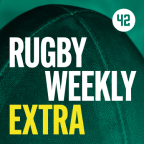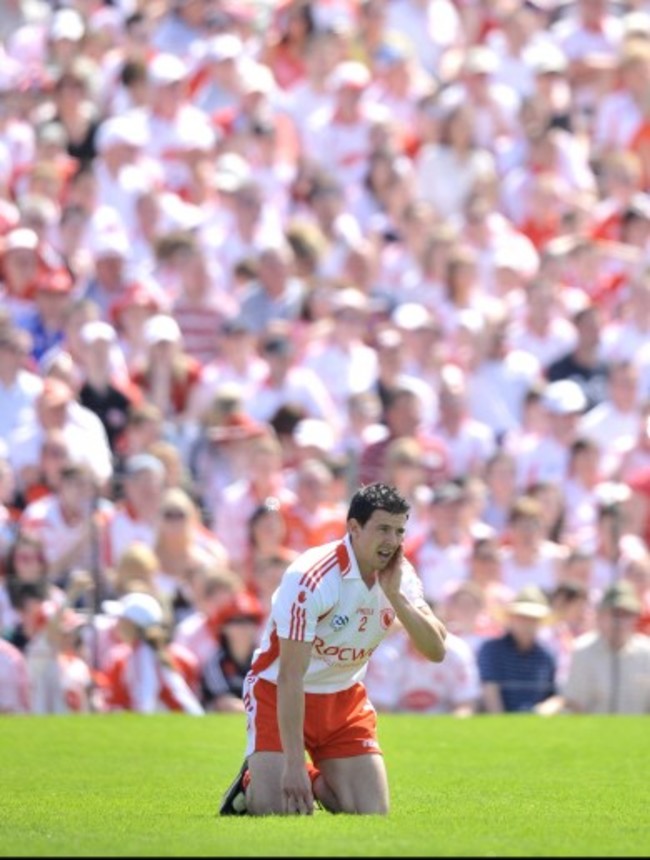PJ QUINN CASTS his mind back to the day he started to realise the gig might be up.
An All-Ireland SFC winner in his first year on the Tyrone panel in 2008, he played through the pain barrier for a number of seasons before his hips started to get really bad in 2014.
“I’d worn the cartilage away in both hip joints,” he told The42. “In 2014 as soon as we went back on the training field again the hip kept giving me trouble. I was getting really frustrated and in a lot of pain.”
His final game for Tyrone came in their qualifier defeat to Armagh that summer. “I was marking Jamie Clarke that day and in the first five or six minutes, he side-stepped me and the hip just left me again. I just knew I was in severe bother at that stage.
“I had to do a 15-minute warm-up before the warm-up actually started. When I got going the adrenaline and stuff carried me through. But when the hip decided to go on you it was like someone stabbing you in the heart. It was just bone on bone.”
It was during the club campaign with Moortown that winter when the pain in his hips started to become unbearable. They played neighbours Clonoe in a league game. He got through the first-half fine, but once the adrenaline wore off at half-time his hips started to seize up.
“I found it really, really painful to get going again. After that game I came home and my mother was actually up visiting. I was doubled over in pain and had to hold the fireplace to walk across to the other side of the room.
“My mother just put her hand over her mouth in pure shock and said, ‘PJ son, you’ve done enough. It’s time to step away.’”
Quinn first started experiencing pain around 2011 or 2012. An initial scan showed up a labral tear in his left hip, a relatively common injury for inter-county players.
“So as us players do, we get injected and try get back onto the field as quick as possible,” he recalls. “That injection settled the pain and I got through 2013 relatively pain-free.
“It’s bred into us we just want to get back onto the pitch playing. So whatever that takes you do it. If it’s the physio prescribing injections then you go and take them without worrying about the long-term effects.
“That’s what the young and stupid boys do. I was just trying to get my place back. That cortisone injection that we get, you’re papering over the cracks. You’re able to train away, it just numbs the pain basically.
“I was constantly doing rehab because I was having lower back pain that was due to a prolapsed disc.
“Now looking back on the whole thing, it was maybe all coming from the hips. That probably was the reason my back was giving away.
“In 2014, I noticed the pain getting really, really severe. I got two injections then, I got them on both sides as they were as bad as each other.
“They were steroid injections but I knew there was something seriously wrong because a few weeks later I was back in the same pain. So that kept going and the physio team investigated further to see what was wrong.
“They set me for an MRI scan and that’s when I realised how bad a state the hips were actually in.”
The Tyrone physio told him to prepare for the worst. After reading the scan, the surgeon informed him that his hips were in such a state of deterioration they resembled a 70-year-old’s. He was told retirement was his only option.
The former defender was just 28 when he announced his decision to hang up his boots from all levels of football in April 2016. He had two hip operations in an attempt to save his playing career, but they proved unsuccessful.
“When I got my first operation in it was just to clean the hip joint out to try and give me a bit of pain relief for everyday life. It wasn’t even to go back playing sport.
“After I got the other side done, I did the rehab with Tyrone for three or four months until I got to the stage where I was nowhere near getting back. I was still really, really sore so I just had to pull the plug. I hadn’t played since 2014.
“I’m a very positive thinker and I just said I would be the one to decide my future. Just because somebody says everything is bad and I have to quit, doesn’t mean I have to quit. But when the body is no longer letting you do it, you have to listen to it and you realise the professionals are right.
“The troubling thing for me was how the hips deteriorated so badly in a few years from a labral tear on one side to having severe arthritis in both of them.”
The concerning aspect for Quinn is that his hips have continued to decline since his retirement. For the past two seasons, he’s been training a senior club in Tyrone. Even setting up training drills causes him discomfort.
He is in regular pain, struggling to sleep at night and looking at a double hip replacement in the next 18 months. “I don’t take pain relief at all,” he says. “I don’t want to go down that road.”
Last summer he returned to the same surgeon to “see what kind of shape my hips were in now because I can feel my body deteriorating a good bit.”
“Sure as God, the scans came back and the surgeon just told me that since he last operated on me the hips have deteriorated seriously badly,” he sighs. “I’ve two arthritic hips at a high level.
“He says he has to offer me hip replacements. They won’t want to do it because I’m so young but because the way they are and I’m in severe pain he says he has to offer them to me. He’s willing to do the operations.”
The 33-year-old has even changed his job in an attempt to alleviate the stress on his joints.
“I’m a tiler by trade but I’ve gone into the retail side of it now to start selling tiles. I can feel it now even after a day’s work, I’m going home and I have two wee girls of five and three.
“I’m just really, really sore in the evenings now. I have to do something different with my business to try and pay the bills. I’ve just bought a house there. I’m trying to go a different road. It’s 10 grand a hip so I’m hoping the GPA can help me out.
“I spoke with Sean Cavanagh at the very start and he put me in touch with the right people in the GPA. They did contact me and said there’s a certain set of criteria you have to meet.
“I’m one of these people that keeps my head down and gets on with it. I don’t want to open up a can of worms for everybody. As Sean Cavanagh said to me, ‘How many 33-year-olds in Ireland are sitting waiting on a double-hip replacement? No matter what criteria the GPA has, you’re about to hit both of them.’”
It’s a cautionary tale but Quinn is not alone. And the problem only seems to be getting worse. There are countless examples of inter-county players who’ve been forced into early retirement because of hip injuries.
Donegal footballer Luke Keaney went through five hip surgeries and had to retire at 24. Clare All-Ireland winner Darach Honan was forced to hang up his hurl at 27. He told the Sunday Times in 2018 that he is in constant pain due to his hip issues.
In his 2019 annual report, Tom Ryan spoke about his concerns over the number of GAA players undergoing hip surgery.
“I am worried about the increasing numbers of hip surgeries required by players in the 20 – 26 age bracket,” he wrote.
“Over-training is widely reported to be a contributory factor, so continued education amongst players and mentors is clearly required in this area to safeguard payers.”
A review of GAA insurance scheme claims showed that hip surgeries rose from 80 in 2007 to 314 in 2014 – a rise of 392%. It’s highly likely that figure has continued to rise in the intervening years.
Younger players are being increasingly affected too. Renowned hip specialists Eanna Falvey and Patrick Carton appeared in a TG4 documentary in December 2018 which examined the growing problem of long-term injuries in the GAA, particularly in younger players.
In the programme, a young Tipperary dual player spoke about how his hips were worn down through overuse. At 18, he was told that that hip surgery was his only option if he wanted to play GAA again.
In November 2016, Dr Carton said that hip injuries are were at epidemic levels in the GAA. He revealed that 75% of his patients were GAA players and said the average age for surgery had dropped from 31 to 26-years-old.
Dr Falvey has warned in the past that GAA players were risking their careers by insisting on the quick-fix option of hip surgery, rather than choosing longer-term rehabilitation.
It’s common now for inter-county players to undergo hip procedures in the off-season.
“It’s crazy,” Westmeath-based movement coach Shane Flynn says about the number of youngsters coming to his clinic with hip and groin injuries.
“It’s even worse because they’re being broken up with the weights. They’re doing weights ten times more than any of us were doing. ”
Elite underage county players are all part of development squads from their early teens. Flynn believes strength and conditioning coaches are putting far too much stress on their young bodies.
“The problem is the coaches can’t see this stuff. They’re going training bodies that are not designed for it. Across the board, we need to change the whole fitness testing approach.
“We need to get rid of certain exercises that are breaking the kids down. They should be focusing on pulling exercises, they shouldn’t be doing push exercises.
“We’re testing them on stuff that we shouldn’t really be focusing on improving, like press-ups, bench press, squatting.
“We don’t want them getting into bad habits at a young age. Everybody is doing strength and conditioning now and young lads are now going into the gym on their own not really having a clue.”
Looking back now, Quinn is certain his load wasn’t properly managed. He worked as a self-employed floor tiler, regularly carrying loads of 20kg during the day. Then he’d pump weights with the Tyrone squad a few evenings a week.
“I was doing heavy enough grafting all day every day. Running my own business I had to prioritise things as well as trying to be an inter-county footballer.
“Then you’re going to the gym in the evenings and loading your hips again. I would really put it across that it’s all to do with flexibility now. I’m no expert on strength and conditioning or anything like that, but I always looked after myself.
“Any young lad that asks me now, even in my own club, about what they can do I just tell them, ‘Be flexible. Stop lifting stuff.’ The people that are telling you to lift stuff don’t know what you’re doing during the day. They don’t know how your body is going to react to it, but they’re all getting absolutely plagued out of it. I would be promoting flexibility.
“I think a lot of mistakes were made in the past. ‘Let’s bulk the bodies up and be fit for nothing’ as opposed to now going, ‘Let’s bulk the bodies up but be flexible in the same way.’”
Flynn says that the quick-fix method of surgery players are opting for often doesn’t actually address the issue.
At his NGS Fitness gym in Mullingar, he has worked with a number of high-profile inter-county stars in recent years, including Monaghan’s Conor McManus, Kerry’s James O’Donoghue and Dublin’s Conor McHugh.
Back in 2017, McManus admitted he was looking at the prospect of hip replacement surgery after his playing days due to a hip impingement. He’s now playing pain-free after working with Flynn.
Many times, it’s the foot position and bad technique that’s causing injury in athletes, he believes. “We sit in these bad positions, all of a sudden the hip gets chronically tight and hip impingements develop. The hip impingement issue is majorly from the loading. They’re talking about overtraining, it’s not about overtraining.
“It’s because we’ve been doing damage for five to six years. Some people have been doing damage for 10 years.”
For the past 18 months, Flynn has been using unconventional methods to help GAA players avoid the surgical route and repair hip problems.
A movement specialist with over 10 years experience in strength and conditioning, he studied neuromuscular therapy and it was through his understanding of the human body that led to him designing his own unique method of treating athletes.
His work is based on tension and compression in the body. “Athletes commonly tell me when they come to the clinic, ‘I’ve never done this before,’” he says.
It all comes back to the human kinetic chain. “Every single last injury comes back to a main point of where a body fires in a certain sling. How we move and become over-dominant in one area.”
Movement specialists use a “whole body” approach to treating injuries. Experts believe the human body works similarly to the cogs in the wheel of a watch. The rotation of one component creates movement and action at another. So when an athlete runs, they raise the left hand and right foot at the same time. The sling goes across the body.
Because of this, the location of an injury is often not the cause behind it. For example, tightness in the left shoulder could lead to an athlete suffering a hip impingement or tearing the hamstring in their right leg. The majority of physios will treat the sore area, without ever getting to the root of the problem.
“It doesn’t matter what the injury is when you identify the sling,” explains Flynn. “And then the rehab I’ve come up with is very, very specific – you literally have to become the movement. You have to repetitively do it over and over and over until the brain rewires and says, ‘This is how I run now.’
“You will always break down when you try to go top speed because your human kinetic chain is breaking down in a certain sling. You are not able to produce as much force that side as you do the other side.
“The faster the athlete you are, the harder it is. If you buy a 1989 car and you drive it, it can run for very cheap. You buy a Ferrari and the slightest little thing goes wrong on it, it could cost you thousands.
“That is the risk and that’s why you’ll see top athletes doing major injuries, ripping things clean off the bone because the force they produce is so strong through that slinging motion that it will rip the life out of another one.”
So when an athlete’s kinetic chain is not properly aligned, injuries will start to occur.
“It’s ground reactional force. So if an athlete is running and his foot is hitting the ground at a wrong angle, his body is shaking. He loses his kinetic energy in the body and it can’t absorb the force. So every last step they take is wrong, it’s breaking them down.
“When they’re told to rest, it will never fix them because you’re not fixing the issue.”
Flynn says hip injuries and even ACL tears are highly preventable and come back to the same principle. “If it can’t match that force, basically the body has to distort itself to cope with that and you’ll see a hip drop or a knee fall in,” he says.
Quinn is adamant that on a larger scale, something is going to have to be done.
“This isn’t to point the finger at physios, they’re under enough stress,” he says. “They’re the same as the GAA, they’re only worried about the present. They don’t really care. They’re employed to get you on the pitch as best they can.
“They don’t really care what happens later down the line because they’re paid to worry about getting this manager’s players fit to win games.
“They don’t care about what’s happened in the past or what’s happening in the future. It’s hard to know, I haven’t got all the answers.”
The42 is on Instagram! Tap the button below on your phone to follow us!












